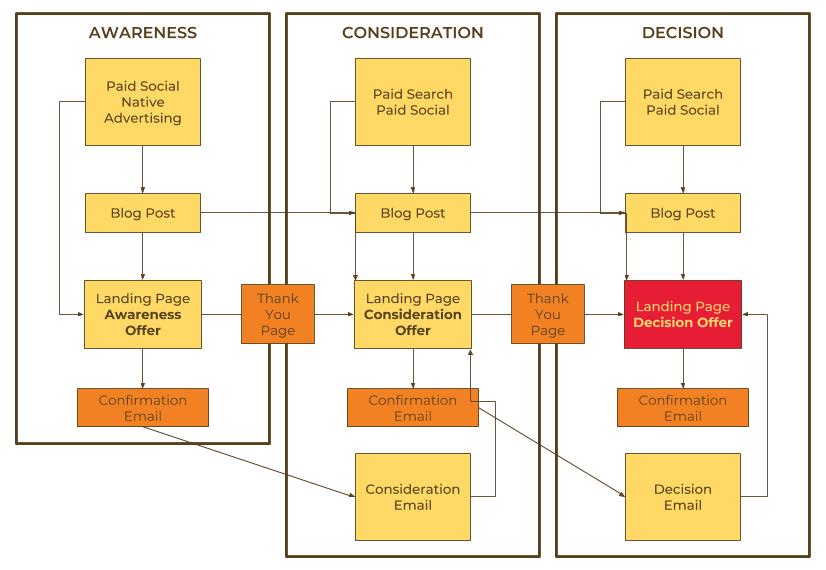How to Nurture Leads for More Conversions
Episode #5 of the course Drive sales with inbound lead generation by Roy Harmon
Like we talked about in the second lesson, almost half of the leads you generate won’t be ready to buy yet. That’s where lead nurturing comes in.
In this lesson, we’re going to talk about how to follow up with your leads to make sure you’re top of mind when they’re ready to make a purchase.
Conversion Maze
To make sure you don’t lose your leads to a competitor, you’ll need to set up a conversion maze of interconnected funnels. Through this series of interconnected funnels, we’ll offer relevant content at each stage of the buyer’s journey.
This gives us a way to guide prospects to exactly what they’re looking for (without wasting our time on people who aren’t interested).
Here’s how the concept looks on paper:

Awareness. As you can see, we start each funnel by generating traffic. At the top of the funnel, broad paid social campaigns and native advertising (through networks like Outbrain and Taboola) are your best bet.
These ads fill the top of your funnel. You can use them to send people to your awareness blog post, the landing page for your awareness offer, or both. The blog post directs them to the landing page for your awareness offer.
If they download the awareness offer, two things happen at once. They’re sent a confirmation email with a link to the download page included, and they’re sent to a thank you page that—in addition to the download they signed up for—includes a consideration offer, in case they’re ready to move further down the funnel.
You’ll want to set up a remarketing campaign to continue advertising awareness offers and blog posts to people who visit your page but don’t download an offer.
Consideration. You’ll fill your consideration stage funnel with paid search ads that target people searching for solutions to the problem you solve. For instance, with the umbrella example, you would want to show up in searches for, “how to stay dry in the rain.”
The paid social ads will be targeted at a remarketing list of people who have visited your awareness blog post and/or downloaded your awareness stage offer.
Like the first funnel, these ads lead to a blog post, landing page, or both.
The only difference in this stage is that you’ll also want to send an occasional email to contacts who have downloaded your awareness offer to see if they’re ready to move further down the funnel.
Decision. This funnel is like the others, but you’ll fill it up chiefly with search ads targeting searches with purchase intent (e.g., “where to buy an umbrella”).
Fixing a Leaky Funnel
You’ll need to use an analytics tool like Google Analytics to check your funnel for leaks. Are visitors clicking your ad, but then when they get to your blog post, they’re bouncing? Maybe you should rewrite the post, link to a different post, or just send them right to the landing page.
Are visitors who download your Awareness stage offer never moving any further down the funnel? You might want to adjust your ad targeting or change up your offer to make sure you’re attracting the right traffic.
By paying attention to your analytics, you can see which components of your funnel are effective and where you might be losing your prospects, and make changes to improve your conversion rates.
You should always be looking for ways to improve your funnel. Split testing ad copy, calls-to-action, and graphics are some of the more frequently tested variables. You can also test different offers. Be sure to get a large enough sample size before you make any changes.
In the following three lessons, we’ll discuss each of the three funnels in more detail. See you then!
Recommended book
The Psychology of Selling: Increase Your Sales Faster and Easier Than You Ever Thought Possible by Brian Tracy
Share with friends

